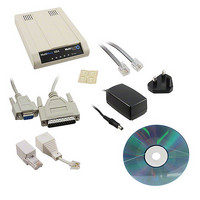MT9234ZBA-V-GB/IE Multi-Tech Systems, MT9234ZBA-V-GB/IE Datasheet - Page 33

MT9234ZBA-V-GB/IE
Manufacturer Part Number
MT9234ZBA-V-GB/IE
Description
MODEM V.92 DATA/FAX/VOICE WORLD
Manufacturer
Multi-Tech Systems
Series
MultiModem® ZBAr
Datasheets
1.MT9234ZBA-NAM.pdf
(2 pages)
2.SF100-G.pdf
(4 pages)
3.MT9234ZBA-USB.pdf
(66 pages)
4.MT9234ZBA-EU.pdf
(8 pages)
5.MT9234ZBA-EU.pdf
(35 pages)
Specifications of MT9234ZBA-V-GB/IE
Data Format
V.34, V.92
Baud Rates
-
Interface
RS-232
Voltage - Supply
-
Mounting Type
Desktop
Package / Case
5.7" L x 4.3" W x 1.0" H (145mm x 109mm x 25mm)
Lead Free Status / Rohs Status
Lead free / RoHS Compliant
Other names
881-1143
This appendix covers the setting up of a router. The router's console port, for example on a Cisco router, is an asynchronous
serial port configured as data communications equipment (DCE).
Step 1: Configure the Modem for your Country or Region
Step 2: Configure for Callback Security in Direct Connect Mode
Multi-Tech Systems, Inc. MT9234ZBA-Series User Guide (S000387D)
Configure the modem defaults to match the requirements of the country/region in which it will be used. For information on
how to do this, see “Step 5: Configure the Modem for your Country or Region” in Chapter 2.
Callback security requires a caller to give a correct password before sending data to the system. If you do not plan to use
this feature, skip to Step 3.
To Turn Direct Connect Callback Security On and Off
To Set the Parity of the Callback Security Messages
To Assign Callback Passwords
To Call a Modem Configured for Callback Security
Callback security must be turned on to enter many callback security commands.
Using a terminal program such as HyperTerminal, type the command AT#Sxxxxxxxx, where xxxxxxxx is your
Type one of the following commands:
Type AT&W0 to store the above commands to nonvolatile memory.
The modem’s password prompt and messages parity must match the parity of the computer to which the modem is
connected.
To store a callback password for the first callback memory location, type AT#CBN0=xxxxxxxx, where xxxxxxxx is
To store a callback password for the second callback memory location, type AT#CBN1=xxxxxxxx, where xxxxxxxx
Repeat as many times as necessary until all passwords have been entered.
To review your entries, type AT&V and press E
To set the modem for direct connect mode, type AT%H1 and press E
Appendix E – Using Out of Band Management
password (1 to 8 characters long; case-sensitive). Press E
password is correct and ERROR if it is wrong. The default password is MTSMODEM. If you wish to change the
password, then type the command AT#S=xxxxxxxx, where xxxxxxxx is the new password (1 to 8 characters
long; case-sensitive), and press E
•
•
1.
2.
the first password. Press E
case-sensitive, and must not contain a + or - character.
is the second password, and press E
incremented by one.
1.
2.
3.
4.
To turn on remote callback security only, type AT#CBS2 and press E
To turn on both local and remote callback security, type AT#CBS1 and press E
turned on, you must enter the setup password before you can enter any AT command from a local terminal
except the AT, ATIn, and AT#Sxxxxxxxx commands.
The default parity setting for your modem is no parity (AT#CBP0). To change the modem’s prompt
messages to use even parity, type AT#CBP2 and press E
E
To store the new parity value, type AT&W and press E
Using a terminal program and an originating modem, dial the number of the modem connected to the
Cisco router, which we will call the “remote modem.”
When connection is established, the remote modem responds: Password>
Type a direct connection password, and press E
valid password.
If the password is valid, the message OK Connecting appears and the modems establish a working
connection.
NTER
.
NTER
. The password must be unique, must be 6 to 10 characters in length and
NTER
NTER
.
. Note that the memory location number in the command is
NTER
.
NTER
. You have three attempts or one minute to enter a
NTER
NTER
NTER
. The modem responds with OK if the setup
.
NTER
Appendix E – Connecting to a Cisco Router
. For odd parity, type AT#CBP1 and press
.
NTER
.
NTER
. When local security is
33













